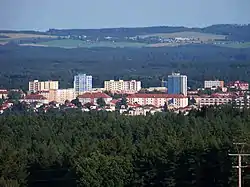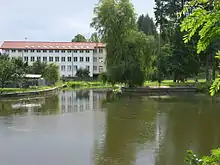Sezimovo Ústí | |
|---|---|
 General view from the west | |
 Flag  Coat of arms | |
 Sezimovo Ústí Location in the Czech Republic | |
| Coordinates: 49°23′7″N 14°41′4″E / 49.38528°N 14.68444°E | |
| Country | |
| Region | South Bohemian |
| District | Tábor |
| First mentioned | 1250 |
| Government | |
| • Mayor | Martin Doležal |
| Area | |
| • Total | 8.44 km2 (3.26 sq mi) |
| Elevation | 399 m (1,309 ft) |
| Population (2023-01-01)[1] | |
| • Total | 7,166 |
| • Density | 850/km2 (2,200/sq mi) |
| Time zone | UTC+1 (CET) |
| • Summer (DST) | UTC+2 (CEST) |
| Postal code | 391 01, 391 02 |
| Website | www |
Sezimovo Ústí (Czech pronunciation: [ˈsɛzɪmovo ˈuːsciː]; German: Alttabor) is a town in Tábor District in the South Bohemian Region of the Czech Republic. It has about 7,200 inhabitants.
Administrative parts
Sezimovo Ústí is formed by one administrative part.
Etymology
The name literally means "Sezima's river mouth".
Geography

Sezimovo Ústí is urbanistically fused with the neighbouring towns Tábor in the north and Planá nad Lužnicí in the south. It is located about 47 kilometres (29 mi) north of České Budějovice and 72 km (45 mi) south of Prague.
Sezimovo Ústí lies in the Tábor Uplands. It is situated at the confluence of the Lužnice river (which makes the border of the municipal territory) and Chotovinský Stream (also called Kozský in the length where it flows through the town). One of the tributaries of the Chotovinský Stream supplies a fish pond called Jezero.
History

According to legend, Sezimovo Ústí was founded by Sezima, an illegitimate son of Witiko of Prčice. The town was established in the first half of the 13th century. The first mention of Ústí is from 1250, when the general chapter of the Dominican Order agreed to the consecration of the monastery church to Saint Dominic. The town prospered, which resulted from a convenient place on the way from Austria to Prague.[2] Only six years after the church was consecrated, the monastery was expanded so the town must have already be prosperous enough to allow investment like that. The town was later fortified and had three suburbs, one of them on the other bank of the Lužnice river. From 1388, the independent parish church had its own hospital and school.[3]
In 1414, Jan Hus was invited to Sezimovo Ústí to preach in Kozí hrádek Castle, which led the radicalization of many people and establishment of Hussite movement. In 1420, Hussites burned down the town and left to the nearby newly established town of Tábor.[2] Some parts of the abandoned town were still used in the time of King George of Poděbrady and the Dominican friars returned to the damaged monastery after 1420 for some time. Water mill and one farm was also on the grounds of the old town for most of the time after the town was abandoned.[4]
In 1828, a new village was founded and was named Starý Tábor ("Old Tábor").[2] About 80 houses were built or under construction in 1832.[5] Construction of the new church started in 1835 and it was consecrated in 1841.[6] In 1920, the village was promoted to a town and returned to its historical name of Sezimovo Ústí. In 1939, the entrepreneur Jan Antonín Baťa built a factory and began to build a new district of Sezimovo Ústí, nowadays called Sezimovo Ústí 2.[2] During World War II, Sezimovo Ústí was incorporated into Tábor, which lasted until 30 June 1945.[5]
Demographics
|
|
| ||||||||||||||||||||||||||||||||||||||||||||||||||||||
| Source: Censuses[7][8] | ||||||||||||||||||||||||||||||||||||||||||||||||||||||||
Economy
The largest employer based in Sezimovo Ústí is Kovosvit MAS Machine Tools, a manufacturer of machine tools with 250–499 employees.[9]
Transport
The D3 motorway (part of the European route E55) from Tábor to České Budějovice runs next to the town.
Sezimovo Ústí lies on the railway line heading from Prague to České Budějovice.
Sport
The main sport clubs in Sezimovo Ústí are TJ Spartak MAS and TJ Sokol Sezimovo Ústí. Sezimovo Ústí has one swimming pool.
Sights

Kozí hrádek is a castle ruin near Sezimovo Ústí, known for activities of Jan Hus. It is unknown when it was built, but it was first mentioned in 1377. It was built in Gothic style. In 1438, it was burnt down. The castle is protected as a national cultural monument. The ruins are accessible to the public.[10]
The villa of Czechoslovak president Edvard Beneš in Sezimovo Ústí was his favourite place of recreation, and the site of his burial. The villa's garden with the grave is open to the public. The villa itself is open only partially as it is still used by the Government of the Czech Republic. There is also the monument with an exposition of political and social life of E. Beneš and his wife.[11]
The Church of Exaltation of the Holy Cross was built in the late Empire style in 1841. In the park near the town hall there is a stone baptismal font and few stone fragments as the only remains from the original town which stood here until 1420.[2]
Notable people
- Jan Hus (1371–1415), theologian, philosopher and reformer; preached here
- Edvard Beneš (1884–1948), politician, President of Czechoslovakia; died here
- Václav Kaplický (1895–1982) writer, journalist and epic poet
- František Němec (born 1943), actor
- Bohumil Cepák (1951–2021), handball player
International relations
Sezimovo Ústí is a part of the Commonwealth of towns with hussite past and tradition, along with other 11 Czech and 6 German municipalities.[12]
Twin towns – sister cities
Sezimovo Ústí is twinned with:[13]
.svg.png.webp) Thierachern, Switzerland
Thierachern, Switzerland
References
- ↑ "Population of Municipalities – 1 January 2023". Czech Statistical Office. 2023-05-23.
- 1 2 3 4 5 "Sezimovo Ústí" (in Czech). Město Sezimovo Ústí. Retrieved 2021-09-13.
- ↑ Krajíc, Rudolf (2020). "Zaniklé středověké město Sezimovo Ústí" (PDF). Archaeologia Historica (in Czech). 45 (2): 765–783. doi:10.5817/AH2020-2-12. S2CID 235061736. Retrieved 2023-03-18.
- ↑ Obecní kronika obce Ústí Sezimova (in Czech). Sezimovo Ústí, SOkA Tábor. 1924–1930. pp. 14, 45–55. Retrieved 2023-03-18.
- 1 2 Šajtrová, Alena (2015-09-03). "Před 95 lety se Sezimáčtí vrátili ke kořenům" (in Czech). Deník.cz. Retrieved 2023-05-15.
- ↑ Šnejd, Jan (2017). "Máme kroniku" (PDF). Farní zpravodaj (in Czech). Farnost Tábor (Velikonoce): 2. Retrieved 2023-03-18.
- ↑ "Historický lexikon obcí České republiky 1869–2011 – Okres Tábor" (in Czech). Czech Statistical Office. 2015-12-21. pp. 15–16.
- ↑ "Population Census 2021: Population by sex". Public Database. Czech Statistical Office. 2021-03-27.
- ↑ "Registr ekonomických subjektů". Business Register (in Czech). Czech Statistical Office. Retrieved 2023-05-15.
- ↑ "Historie" (in Czech). Kozí hrádek. Retrieved 2021-09-12.
- ↑ "Památník dr. Edvarda Beneše, prezidenta republiky" (in Czech). Hussite Museum in Tábor. Retrieved 2021-09-12.
- ↑ "Města" (in Czech). Společenství měst s husitskou minulostí a tradicí. Retrieved 2020-08-24.
- ↑ "Spolupráce měst" (in Czech). Město Sezimovo Ústí. Retrieved 2021-09-13.